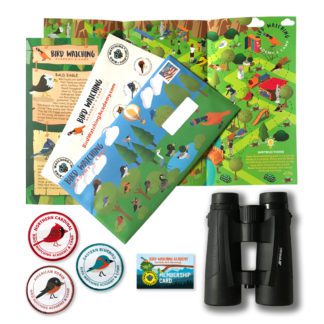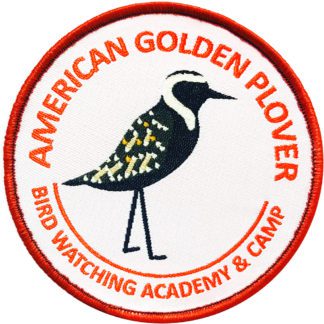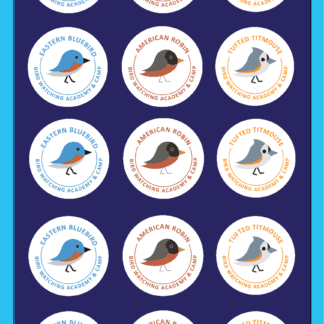
For a relatively small bird species, the American Golden-Plover certainly has a spark of elegance to them. Especially if you catch them in flight, you’ll be amazed at the swift grace present in their wings movement. They are also suspected to be the fastest among the shorebirds. And they have to be since it’s no easy task flying from the Arctic tundra of Alaska and Canada to the south side of South America.
In spring, their plumage takes on a wonderful color, wandering around Mississippi Valley and the great plains. They tend to maintain some distance from water areas, preferring to stay in drylands with green pastures or prairies. Today, we’ll learn more about the habits of American Golden-Plovers:
- American Golden Plover color patterns, songs, and size
- American Golden Plover behavior, habitat, and diet
- American Golden Plover life cycle, nesting, and migration range
GET KIDS BIRD WATCHING
American Golden-Plovers Color Pattern
If you ever do manage to spot an American Golden-Plover, it would turn out to be one of the most delightful moments of your life. The sheer amount of color on their plumage is something to marvel at. These small shorebirds have a deep, dark bill. The breeding male American Golden-Plovers have a black color face and neck and top of the head. However, a stripe of white runs down their crown and then merges with their neck from the sides. Their chest, underparts are also a gorgeous shade of black. Then, the upper body of the American Golden-Plovers consists of mottled gold, black, brown, and white in a small triangle shape all mingling with one another. It is kind of like the pattern of sweet chocolate.
The breeding female American Golden-Plovers look the same as their male counterpart for the most part. Except, the underparts, their face, the top of their head and their chest is a paler brown color instead. The white stripe is still present but it is dulled and it seems there’s the slightest shade of brown over it. Their upper parts continue to have the same mottled gold, white and brown combination.
The juvenile American Golden-Plovers have a more gray-brown color all over their body. There is a pale stripe around their eyebrows. The underparts happen to be more gray than brown.
Description And Identification
Identifying American Golden-Plovers might be one of the easiest things you would ever do. Their color pattern alone makes it clear that it is no one but this particular species of shorebirds. There are not many shorebirds that can boast about having mottled gold, brown, black and white colors mixed together on the upper part of their plumage. The distinct white stripe from their crown to the side of their neck also makes it easier to identify them. The patterns look either like colorful easter eggs or floor tiles with colorful patterns. Oddly enough, despite having so many colors on their body, due to their choice of habitat, they can easily camouflage among the vegetation.
They prefer large open fields but when they are walking on the dry grounds, the brown and black of their body makes them unnoticeable a lot of the time. They are also small birds and if you are not paying close attention, it won’t occur to you that they might be just on the ground, hiding in plain sight.
Sometimes, you might catch them flying overhead. When they do so, they take long flights and it is impossible to see them properly. From the ground, you can also mostly see the black or brown underparts so it is impossible to always tell it is American Golden-Plovers. Your best chance of identifying them is when they are searching for food on the ground.
You could try identifying them by their call or their song too. Both of these sounds they make happen to have whistling noises. Their song is abrupt and happens in quick succession. It is as if you hear one whistle after another. When they are flying, they make “tuuue” whistling sounds which are not always easy to hear from the ground.
As a birdwatcher, your best chance of seeing them is during the migration period. They stop over parts of Central America with prairies and pastures. They might appear in an open field near your house one day. Try and make a map of the route American Golden-Plovers take. You can try and follow them along those routes in the right season if you really want to see one.
As a birder, don’t forget to take all your important gear with you. These are small birds so you will need your binoculars.
American Golden-Plover Song
When they are flying, American Golden-Plovers let out this call that sounds like a whistle of either “que del” or “tuu ue”. Even their song is basically whistling sounds that begin abruptly as it ends.
American Golden-Plover Size
The size of American Golden-Plovers is best described as the beautiful balance between a Crow and a Robin. It is bigger than a robin but smaller than a Crow. In length, they happen to be about 24 to 28 cm. In weight, they can be anywhere from 122 to 194 g. Their wingspan is long and suitable for long fights. It tends to be about 65 to 67 cm.
American Golden-Plover Behavior
American Golden-Plovers don’t actually have any proper pattern to the way they forage. They almost seem uninterested in eating with the way they go about it. They will walk around on the ground or run around and then come to a halt. Then, they will resume their journey. All the while, if they find something they can peck at, they will. If something edible comes along the way, it is their lucky day. This could be due to their ability to store the food they have eaten previously as fat, which helps them keep their energy up for long periods of time. They also have a habit of bobbing their head when they pause in their short walks.
One of the most amazing things about American Golden-Plovers is their flying ability. As far as migratory birds are considered, American Golden-Plovers take one of the largest journeys. In this journey, they cross over about 40000 km. 3900 km of them happens to be above the ocean where they can’t get access to fresh food or water. Yet, there is no cause for worry as they can store body fats for a long period of time. Before they take off on their long journey, they stock up generously.
What American Golden-Plovers Eat
American Golden-Plovers mostly survive on insects. If they are on their breeding ground, it is more so the case. Beetles, flies, snails are among the insects they feed on along with seeds. When they are migrating and they fly over large fields, their diet gets a variety in terms of insects. Caterpillars, larvae, grasshoppers, are now included in the list. When they are around ocean areas, they will find small sea fish. Then, towards the end of summer, they enjoy the delicious juiciness of berries.
Where American Golden-Plovers Live And Habitat
Their winter grounds consist mostly of shores, prairies, and mudflats. In summer, they find the tundra idea for breeding. Their migration period, you will mostly catch them on pastures, prairies with short grass, and fields plowed in. They show up on beaches and mudflats less often.
The American Golden-Plovers that are in west Alaska meet lots of Pacific Golden-Plovers. Here, the American Golden-Plovers are likely to nest higher, where the tundra slope happens to be more barren.
Range and Migration

The breeding range for American Golden-Plover is Alaska and northern Canada, that is, the Arctic Tundra. These migratory birds choose to spend their winter in the southern part of South America. They follow what one might call an oval migratory route. The birds headed north to go over Central America from January to April. A whole lot of them stop over places such as Illinois before continuing on North in one go.
Come fall, their path strays eastward. They pass the Caribbean sea and the west side of the Atlantic before reaching Patagonia, where they winter. American Golden-Plovers are known for having a long migratory route. They fly for about 40,000 km. 3900 km of this is spent flying across vast oceans where they don’t have any place to rest for food or water. Instead, they store body fat prior to taking off on their long journey.
American Golden-Plover Life Cycle
Usually, American Golden-Plovers give birth to about 4 eggs. A brood might have 3 eggs instead. The egg color can range from a buff, pale color to darker cinnamon. The sides have bold blotches of brown and black. The tundra vegetation is ideal for hiding these kinds of colors, letting the eggs go easily unnoticed by predators.
Both sets of parents take part in incubation and it can take anywhere from 26 to 27 days. Most reports suggest the male American Golden-Plover takes part in incubation during the day while the female plover takes care of her unhatched eggs at night.
Young American Golden-Plovers become independent not long after their eggs hatch. It doesn’t take long before they are deemed capable of leaving their nests. Even though the parents take care of the young ones and are more than happy to find food for them, they tend to search for food on their own regardless. At about 22 to 24 days, they try their wings on their first flight.
Nesting
Male American Golden-Plovers are seen doing flight displays where their breeding ground happens to be. Their wing beat turns slow and more pronounced while they fly over the territory they have chosen. Along with it, you can hear their “kt-dlink” call.
The courtship period sees a male American Golden-Plover walking up to the female while their posture stays crouched and their neck is extended. They also outstretch their tail.
For the nest, they prefer the ground, usually on the dryness of the tundra. The nest also isn’t hidden from view and there is usually no need for it. It is unknown who builds the nest, though the assumption is that it is the job of the male American Golden-Plovers. It is placed in a depression that’s narrow on the ground and moss, lichens, and leaves are used to line it.
Anatomy of an American Golden-Plover
Adult American Golden-Plovers can be medium-sized to large. They have a decent amount of legs for their body shape and it isn’t too thin. Their neck region ends quickly and they have a short bill. On the other hand, their head happens to be large for their size and is wonderfully rounded.
The bill of female American Golden-Plovers happens to be slender and short. All the birds have dark, huge eyes that take about half of their face.
The juvenile American Golden-Plovers have larger wings that go beyond the size of their tail. They also have small heads unlike what they have as adults. The head is so small that it looks as though it belongs to a dove.
Final Thoughts
If you have learned anything from this guide, it’s probably how much American Golden-Plovers have a preference for mudflats, open areas, and pastures. They are willing to make incredibly long journeys and cover huge distances among all the migratory birds for their preferred habitat. While it is unlikely that you can wander around the Arctic tundra of Canada and Alaska where American Golden-Plovers breed, you can certainly wait for them in places like Illinois, where they stage for some time.
Unfortunately, their conservation status isn’t the most encouraging at the moment. Towards the end of the 19th century, a huge number of the population was shot. It seems they never fully recovered from that and never managed to go back to their original count. The deforestation occurring in their wintering range in South America isn’t helping the matter any.
So, while it is not impossible to come across American Golden-Plovers today, you have to find the right habitat if you want to see them once.
Bird Coloring Page
American Golden-Plovers Bird coloring pages and coloring pictures have somewhat taken a back seat in the child’s development stage. Many children are becoming gadget-friendly and don’t like to do anything that involves something physical. Although cute coloring pages and coloring pictures might seem like a simple task, believe me, it has so many advantages. It excites children, and motivates them, and is a healthy educational activity. Here are some benefits of coloring pages for children.

Ornithology
Bird Watching Academy & Camp Subscription Boxes
At the Bird Watching Academy & Camp we help kids, youth, and adults get excited and involved in bird watching. We have several monthly subscription boxes that you can subscribe to. Our monthly subscription boxes help kids, youth, and adults learn about birds, bird watching, and bird conservation.
-
 Kids Bird Watching Monthly Subscription with 10×42 Binoculars$10.00 / month and a $58.00 sign-up fee
Kids Bird Watching Monthly Subscription with 10×42 Binoculars$10.00 / month and a $58.00 sign-up fee -
 12 Month Prepaid Bird Watching Subscription – 1 patch a month$84.00
12 Month Prepaid Bird Watching Subscription – 1 patch a month$84.00 -
 12 Month Prepaid Bird Watching Subscription – 3 patches a month$120.00
12 Month Prepaid Bird Watching Subscription – 3 patches a month$120.00
Bird Watching Binoculars for Identifying American Golden-Plover
The most common types of bird-watching binoculars for viewing American Golden-Plover are 8×21 binoculars and 10×42 binoculars. Bird Watching Academy & Camp sells really nice 8×21 binoculars and 10×42 binoculars. You can view and purchase them here.
-
 Birding Binoculars$49.99
Birding Binoculars$49.99 -
 Kids Binoculars$13.99
Kids Binoculars$13.99
American Golden-Plovers Iron On Patches
Kids, Youth, and Adults love to collect our Bird Watching Academy & Camp iron-on patches. Our bird-watching patches help you keep track of the birds you have seen and identified. You can also display the patches on our Bird Watching Academy & Camp banners.
The American Golden-Plovers is a great iron-on patch to start your collection with. The patches are durable and can be sewn on or ironed on to just about anything.
-
 American Golden Plover Iron on Patch$2.99
American Golden Plover Iron on Patch$2.99 -
 Bird Banner$10.99
Bird Banner$10.99
American Golden-Plover Stickers
Stickers are a great way for you to display your love for bird watching and the American Golden-Plovers. Here is the sticker pack we sell with an American Golden-Plover sticker.
Bird Feeders For American Golden-Plover
There are many types of bird feeders. Bird feeders are a great addition to your backyard. Bird feeders will increase the chances of attracting birds drastically. Both kids and adults will have a great time watching birds eat at these bird feeders. There are a wide variety of bird feeders on the market and it is important to find the best fit for you and your backyard.
Best Birdhouses for American Golden-Plover
There are many types of birdhouses. Building a birdhouse is always fun but can be frustrating. These 4 birdhouses have become our favorites. Getting a birdhouse for kids to watch birds grow is always fun. We spent a little extra money on these birdhouses but they have been worth the higher price and look great.





















